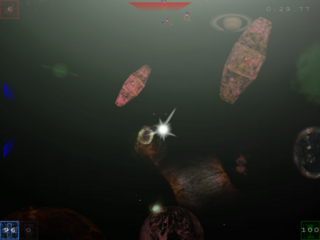Adanaxis
| Adanaxis | |
|---|---|
 Adanaxis 1.2.5, level 4 (low detail). Note the transparency levels and colorful dot angles. | |
| Genre | A single-player 4D first person shooter in outer space |
| Latest release | 1.5.14 (Announcement) |
| Release date | October 3rd, 2020 |
| Developer | Mushware Limited (Andy Southgate) |
| Code licenses | GPLv2; an irrelevant non-free file in the commercial version ($18.95) |
| Media licenses | GPLv2; non-free files in the commercial version |
| P. languages | C++ |
| Libraries | GLUT |
| Homepage | https://mushware.com/categories/adanaxis |
| Contribute | |
| Adanaxis is a free game. This means that the source code is available to be studied, modified, and distributed. Most projects look for help with testing, documentation, graphics, etc., as well. | |
Adanaxis is a deep space first-person shooter game in four spatial dimensions, written by Andy Southgate. The latest version of the game is 1.5.14, released on October 3, 2020. It is written in the C++ programming language using the GLUT library.
History[edit]
The 4D aspects first appeared in the game in 2005.[1]
Licensing[edit]
The game is distributed under the Mushware Software License version 1.4, which refers to the GNU GPL v2, the public domain, proprietary and a number of other licenses.
The commercial version sold from the author’s website contains some encrypted non-free media. There is also a piece of non-free code (MushSecret.cpp) needed only to work with those files.
Availability[edit]
The author submitted a free GPLv2-compatible version of Adanaxis with those media and code removed to free operating system repositories.[2] They include at least Debian (since lenny/sid)[3] (maintained by Debian Games Team, uploaded by Barry deFreese)[4], Fedora (7, 8, 9), Ubuntu (since hardy)[5].
Gameplay[edit]
4D[edit]
Adanaxis is designed to minimise the visibility and impact of 4D on the player. With just one extra control required, the game looks and plays a lot like a 3D shooter, with another aiming stage added on.[1]
It uses 3D for rendering, and things like explosions, planets and galaxies look “normal”.
But other objects are rendered, very roughly, as projections of 4D objects on the 2D screen.[6] In the game manual, the author says he didn’t yet figure out how to implement real 4D and 4D explosions without making the game require a thousand times more processing power.[1]
Aiming[edit]
Targeting is helped by 3 color markers moving around the crosshair.
- Red: x axis. Move mouse left/right to aim
- Green: y axis. Move mouse up/down to aim
- Blue: z or hidden axis. Move mouse left/right whilst holding down the right mouse button or space bar to aim
Weapons[edit]
- The basic Plasma Spitter is self-recharging but does minimal damage. Projectiles are guided, so once the player's crosshairs have registered a target (by turning blue or red) these projectiles will be guided to that target.
- The Machine Cannon provides more rapid fire than the base weapon. Damage is minimal and projectiles are unguided. Useful at close to medium range on lightly armoured targets.
- The short range Plasma Flak variant of the Spitter. Very effective at point blank range or in a target-rich environment.
- The Machine Cannon provides a rapid rate of fire that overwhelms its target quickly. It also rapidly exhausts its ammunition.
- Heavy Cannon projectiles are simple and effective. Dense and fast moving, their repeated impact does enormous damage and can rapidly destroy targets.
- The range and power of the Beam Artillery makes it ideal for long-range engagements. There is a downside to that power - it will destroy anything that the target is carrying along with the target.
- Guided Ordnance is a medium range guided missile. Ideal for picking off a number of distant lightly armoured craft, or deployed en masse against a larger target.
- Heavy Guided Ordnance carries a high yield warhead and will damage both the target and surrounding objects. Also has excellent seek characteristics, long range and rarely loses a target.
- A captured device named the Gravity Sink. Precise characteristics are unknown. The weapon appears to be gravitational in nature, but has never been seen in operation.
- The Heavy Demolition Charge is cumbersome and slow to deploy, but the results are astounding. Fitted with a five second fuse. Its enormous blast radius makes it unwise to hit the target and cause early detonation. Aim to miss.[1]
Health and Shield[edit]
- The health display shows the basic condition of the player's craft, and when it reaches zero his/her craft can’t go on any more. Health boxes can be collected to improve the state of things.
- The shield protects the player's health from damage. Collecting shield boxes increases the shield strength to provide better protection.[1]
Reception[edit]
There was an article about Adanaxis in Spanish Linux Magazine[7] in November 2008[8], on pages 87 and 88[9].
The game received a mixed reception; some like it, but others expected something like Tesseract Trainer or a similar experience after reading “4D”. As a result, before November 2008, only 14 people have registered Adanaxis.[10]
References[edit]
- ↑ 1.0 1.1 1.2 1.3 1.4 1.5 About_Adanaxis.pdf in the game’s data package.
- ↑ Interview with Andy Southgate, 2007-08-09, Linux Gaming World
- ↑ Copyright file for the current Adanaxis package in Debian
- ↑ Overview of adanaxisgpl source package in Debian accessed on 2008-10-17
- ↑ adanaxisgpl in Ubuntu Hardy universe repository
- ↑ To try to understand it, see Tesseract Trainer and look info on the tesseract up elsewhere.
- ↑ Contents of Linux Magazine Número 43 (accessed on 2009-03-06)
- ↑ http://www.softwarelibre.net/linux_magazine_nov_2008 (accessed on 2009-03-06)
- ↑ http://dialnet.unirioja.es/servlet/articulo?codigo=2740383 (accessed on 2009-03-06)
- ↑ Any new development? at the Mushware forum (accessed on 2009-03-06)